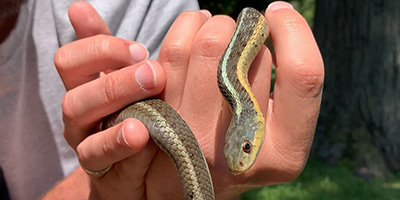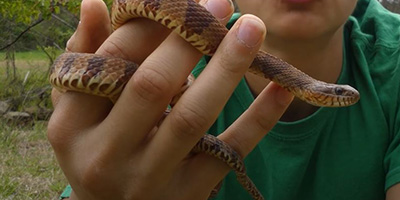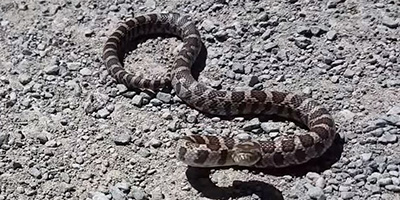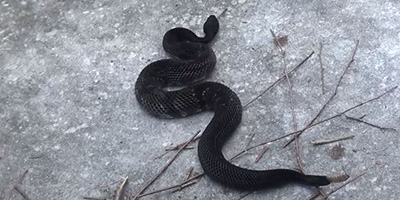
Welcome to trentonsnakes.com! I am David, a snake enthusiast living in Trenton, NJ. Many people don't know that Trenton is in fact full of snakes! You just need to know where to find them - they can often be shy and elusive. Some New Jersey snake species are more common outside of the city limits, in different parts of Mercer County NJ, but many types of snakes are indeed common in the more urban parts of Trenton. This guide is meant to help educate you about the beautiful snakes of Trenton, and to help you identify the most common snakes of Trenton, as well as the venomous snakes of Trenton that you should learn to recognize and avoid. If you want more detail, click here for my complete list of ALL snake species in Trenton. Remember the following:
- Most snakes of Trenton are harmless and don't want to encounter you
- Venomous snakes exist but are uncommon in Trenton, New Jersey
- Snakes eat rats and mice and are a valuable part of the New Jersey ecosystem
- Never kill a snake - if you leave a snake alone, it will leave you alone.
Common Snake Species in Trenton
 Eastern Garter Snake:
The eastern garter snake is commonly mistaken for the eastern ribbon snake. However, eastern garter snakes are usually black, greenish-brown, tan, and sometimes gray. They also usually have one long stripe running down their back. They also possess three thin stripes around the length of their bodies. These stripes tend to be yellow, blue, white, brown, or green. There are occasions however where they lack the stripes. These snakes can range from 18-26 inches in length. They are docile and harmless, and they don’t attack pets or humans. However, they will emit an unpleasant odor if they feel threatened. Their tail can also break off and continue moving to enable the snake to escape from a predator. Their tail can grow back. Their diet consists of insects, frogs, salamanders, and earthworms.
Eastern Garter Snake:
The eastern garter snake is commonly mistaken for the eastern ribbon snake. However, eastern garter snakes are usually black, greenish-brown, tan, and sometimes gray. They also usually have one long stripe running down their back. They also possess three thin stripes around the length of their bodies. These stripes tend to be yellow, blue, white, brown, or green. There are occasions however where they lack the stripes. These snakes can range from 18-26 inches in length. They are docile and harmless, and they don’t attack pets or humans. However, they will emit an unpleasant odor if they feel threatened. Their tail can also break off and continue moving to enable the snake to escape from a predator. Their tail can grow back. Their diet consists of insects, frogs, salamanders, and earthworms.
 Northern Water Snake:
One can identify a northern water snake through their hourglass pattern. Their coloration can range anywhere from black to brown to deep red-purple. The average adult length of a northern water snake is around 2 to 4.5 feet. This snake species relies heavily on a diet of fish and amphibians, mainly sunfish, smallmouth bass, minnows, and hog suckers. They can be found in all kinds of aquatic habitats, but they prefer slow-moving or still waters. They like to bask in the sun on rocks in ponds, lakes, and vernal pools. While they are nonvenomous, they are quite temperamental, so practice caution and avoid making the snake feel threatened, or they will strike.
Northern Water Snake:
One can identify a northern water snake through their hourglass pattern. Their coloration can range anywhere from black to brown to deep red-purple. The average adult length of a northern water snake is around 2 to 4.5 feet. This snake species relies heavily on a diet of fish and amphibians, mainly sunfish, smallmouth bass, minnows, and hog suckers. They can be found in all kinds of aquatic habitats, but they prefer slow-moving or still waters. They like to bask in the sun on rocks in ponds, lakes, and vernal pools. While they are nonvenomous, they are quite temperamental, so practice caution and avoid making the snake feel threatened, or they will strike.
 Eastern Milk Snake:
This snake species can also be found throughout the state of New York. This species is slender, with a coloring of anywhere between gray and tan, which is broken by large, dark spots that are colored dark brown or reddish-brown and outlined in black. They are carnivores and their diet mostly consists of small birds, amphibians, invertebrates, and rodents. They like to hunt during night-time but are commonly harmless. They may strike and vibrate repeatedly when threatened, but their bites rarely break the skin, making them harmless to humans.
Eastern Milk Snake:
This snake species can also be found throughout the state of New York. This species is slender, with a coloring of anywhere between gray and tan, which is broken by large, dark spots that are colored dark brown or reddish-brown and outlined in black. They are carnivores and their diet mostly consists of small birds, amphibians, invertebrates, and rodents. They like to hunt during night-time but are commonly harmless. They may strike and vibrate repeatedly when threatened, but their bites rarely break the skin, making them harmless to humans.
Venomous Snake Species in Trenton
 Copperhead:
The copperhead is a large snake found across the eastern United States. Copperheads have bold markings and a body coloration of anywhere between light brown to gray. They have large, thick stripes of chocolate brown running along their backs, which can sometimes appear in an hourglass shape. Juvenile copperheads look relatively the same as adult ones, but their tails are a lighter yellowish in color. This distinct pattern actually allows this snake species to camouflage in woody and forested areas, which is their main habitat. A fully grown copperhead can be anywhere between 24 and 36 inches long. This snake is a carnivore, and they feed mostly on insects, lizards, small birds, and their favorite, cicadas. Practice extreme caution with this snake species because their hunting style is ambushing their prey and injecting them with lethal venom. Like all pit vipers, they have heat-sensitive pits that allow them to see thermal images in order to find their prey easier.
Copperhead:
The copperhead is a large snake found across the eastern United States. Copperheads have bold markings and a body coloration of anywhere between light brown to gray. They have large, thick stripes of chocolate brown running along their backs, which can sometimes appear in an hourglass shape. Juvenile copperheads look relatively the same as adult ones, but their tails are a lighter yellowish in color. This distinct pattern actually allows this snake species to camouflage in woody and forested areas, which is their main habitat. A fully grown copperhead can be anywhere between 24 and 36 inches long. This snake is a carnivore, and they feed mostly on insects, lizards, small birds, and their favorite, cicadas. Practice extreme caution with this snake species because their hunting style is ambushing their prey and injecting them with lethal venom. Like all pit vipers, they have heat-sensitive pits that allow them to see thermal images in order to find their prey easier.
 Timber Rattlesnake:
Also called the canebrake rattlesnake, this species is a large, heavy-bodied snake with a rattle at the end of its tail. They are usually either gray in color, with a pink hue and a pinkish, orange, or brown stripe on their back or a solid black/brown/yellowish coloration with jet black tails that appear velvet-like. They can grow up to 30 to 60 inches in total length, with a record length of being more than 6 feet long. Because of their size, they can eat small to medium-sized prey, like chipmunks, shrews, mice, and amphibians.
Timber Rattlesnake:
Also called the canebrake rattlesnake, this species is a large, heavy-bodied snake with a rattle at the end of its tail. They are usually either gray in color, with a pink hue and a pinkish, orange, or brown stripe on their back or a solid black/brown/yellowish coloration with jet black tails that appear velvet-like. They can grow up to 30 to 60 inches in total length, with a record length of being more than 6 feet long. Because of their size, they can eat small to medium-sized prey, like chipmunks, shrews, mice, and amphibians.
If you're unsure, you can email me a photo of the snake at info@trentonsnakes.com and I will email you back with the snake's species. If you found a snake skin, read my Found a Skin? page, and you can email me a photo of the skin, and I'll identify the snake for you. If you need professional Trenton snake removal help, click my Get Help page, or see the below website sponsor I found, who provides that service.
A Complete Guide on Garter Snakes
Garter snakes are some of the most common snakes that you will find in North America. They can be seen from Florida, all the way to Canada. They are one of the most popular pet snakes due to their social and harmless behavior. While some species of garter snakes have neurotoxic venom, they are not considered fatal to humans. Their name was derived from their uncanny resemblance to the garter that most men used to secure their socks.
What is the Appearance of the Garter Snakes?
Garter snakes may come in a variety of colors. However, most of them will have three stripes, one in the center of their back and one on the lower side. Usually, the strips will have a greenish or yellowish shade; but the color may vary depending on the region and the species. Some species will have an intricate blotchy pattern on the longitudinal stripes that will appear like a stripe. They are small, which is why they are the preferred pet snake of beginners. They will grow at an average of 23-30 inches with a slender body.
What is the Habitat of the Garter Snakes?
Garter snakes can live in a wide range of habitats. They can be found in the grassy knolls. They love to stay close to the water areas, especially on the species found in the dry and hot part of the west. The standard type of garter snake can thrive in different parts of the country, from the Pacific Ocean and into the Atlantic Ocean and to the plains of Canada. While it has been believed that no rattlesnake can thrive in the cold weather of Alaska, a garter snake was found as a roadkill victim at Haines, Alaska.
What is the Common Behavior of Garter Snakes?
Garter snakes will be active during the daytime. They are terrestrial and fast-moving snakes, but there are times they may climb on vines and shrubs. They are also adept swimmers. When they feel threatened, they will release a malodorous scent that will deter the attacker. Due to their small size, they will be vulnerable to a range of predators such as raccoons, squirrels, foxes, snapping turtles, bullfrogs, bears, crows, and hawks. The garter snake will hibernate once the weather becomes too cold. They will retreat in a den together with hundreds of other garter snakes. There were instances when a den was found with more than 8,000 garter snakes.
What is the Diet of Garter Snakes?
Garter Snake will feed mostly on earthworms, small amphibians, and fish. The snake can overpower their prey through their fast reflexes and their sharp fangs. Some species will contain a mild neurotoxic venom that will be enough to result in paralysis, which will make it easy for them to subdue and swallow the smaller prey. While the garter snake is considered a non-venomous snake, its bite can still cause minor irritation and swelling. If this snake has bitten you, be sure to clean the wounded site thoroughly. It may be rare, but allergic reaction has been associated with the saliva of this reptile.
Remember, the term is not poisonous snakes of Trenton, it's venomous snakes of Trenton. Poison is generally something you eat, and venom is injected into you. That said, dangerous snakes are very rare in Trenton. The few venomous snakes of Mercer County are rarely seen. But they are commonly misidentified, so learn about all the snake species of Trenton in order to correctly identify them. These snakes are usually also found in the surrounding towns of Hamilton Township, Trenton, Princeton, Ewing Township, West Windsor Township, Lawrence Township, East Windsor, Robbinsville Township, Hopewell Township, Pennington, Hopewell, Hightstown, Windsor, and the surrounding areas.
Read our article about:
Understanding The Northern Water Snake: Appearance, Biology, Life Cycle, Habitat, Diet, Behavior
trentonsnakes.com domain and hosting costs made possible by the generous support of this sponsor:
